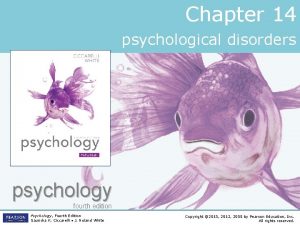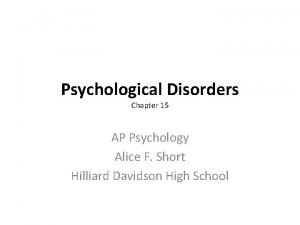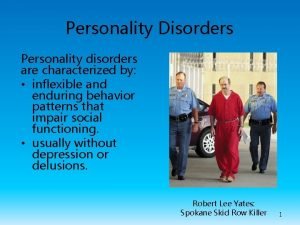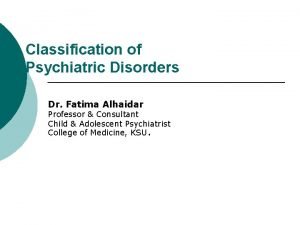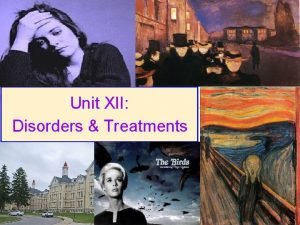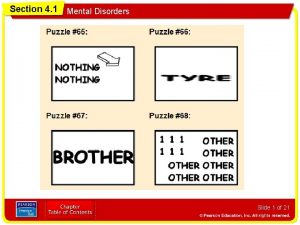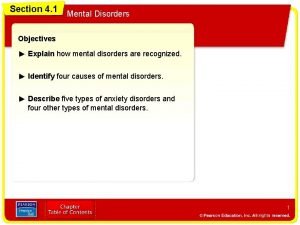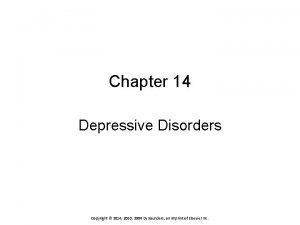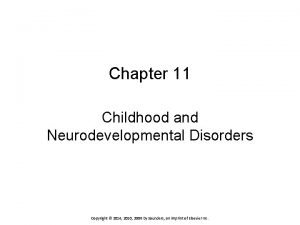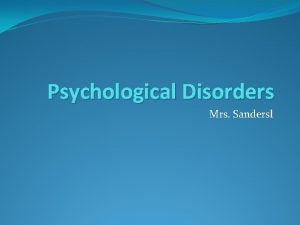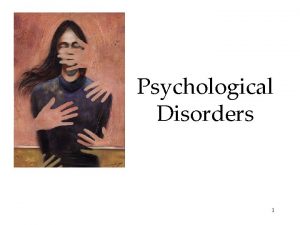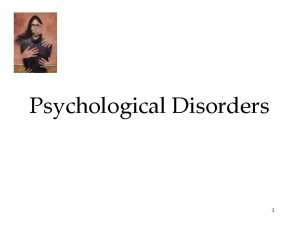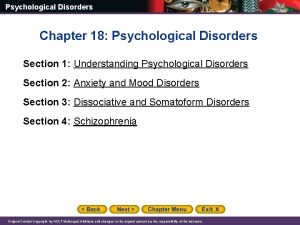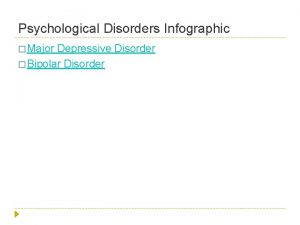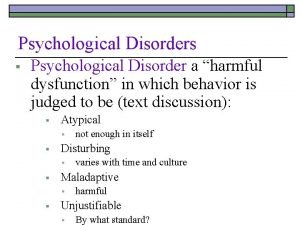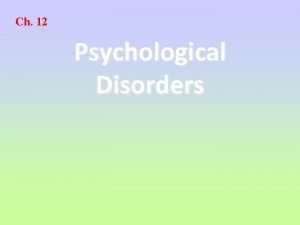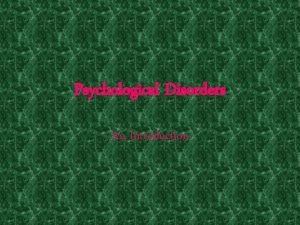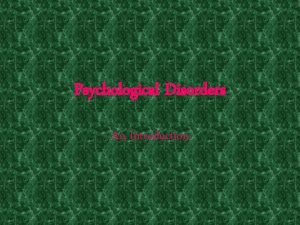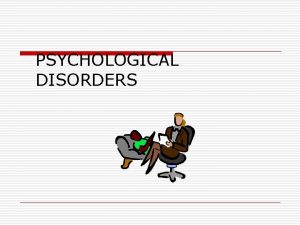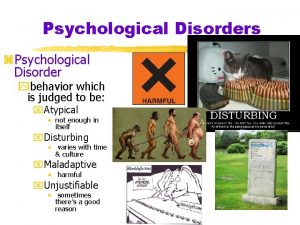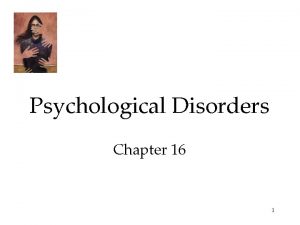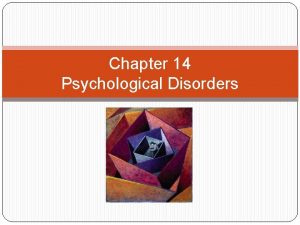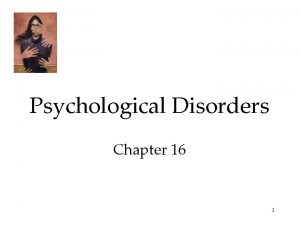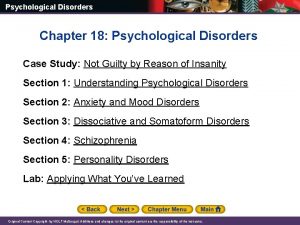Chapter 18 Psychological Disorders Section 1 Psychological Disorder
























- Slides: 24

Chapter 18 – Psychological Disorders Section 1 Psychological Disorder - behavior patterns or mental processes that cause serious personal suffering or interfere with person’s ability to cope with everyday life. What is Normal? Equal with what is average for the majority of people Deviation from the majority becomes criterion for abnormality Symptoms of Psychological Disorder (4 criteria) 1. Typical - how typical the behavior is of people in general 2. Maladaptive - behavior impairs you to function adequately in everyday life (behavior hazardous to oneself and others) ex. Suicide, attacking others 3. Emotional Discomfort - behavior causes emotional discomfort ex. Anxiety, depression 4. Socially Unacceptable Behavior - Culture-Bound Syndromes - cluster of symptoms that define or describe an illness ex. Evil eye - electrical power in eye, called by jealous, hatred affects people; makes them sick, violent, out of blue, not themselves; 1054 - Church believes a general prayer wards off evil spirits

Chapter 18 – Psychological Disorders Section 1 Most people who commit violent crimes DO NOT have PD because aware of what doing. Behavior known to be illegal and held responsible. Majority of those with PD are not violent or dangerous. Classifying Psychological Disorders DSM V - Diagnostic and Statistical Manual of Mental Disorder 6 Major Types 1. Anxiety 2. Dissociative 3. Somotoform 4. Mood 5. Schizophrenia 6. Personality

Chapter 18 – Psychological Disorders Section 2 -Anxiety Disorders Anxiety - general state of dread or uneasiness that occurs in response to a vague or imagined danger. Differs from fear - response to real danger to threat ex. Nervousness, inability to relax, concerned about losing control Physical signs and symptoms of anxiety trembling sweating rapid heart rate shortness of breath increased blood pressure feeling faint Over activity of autonomic system - some people feel anxiety all the time; may interfere with effective living Anxiety disorder - mostly found in US

Chapter 18 – Psychological Disorders Section 2 -Anxiety Disorders Types of Anxiety Disorder 1. Phobic 2. Panic 3. Generalized Anxiety 4. OCD 5. Stress *** Simple Phobia - most common of all anxiety disorders persistent excessive or irrational fear of a particular object or situation; usually don’t seek treatment for disorders Phobic Disorder - fear must interfere with person’s normal life Common Phobia’s claustrophobia arachnophobia zoophobia snakes, blood, needles, storms, dental procedures, driving, air traveling

Chapter 18 – Psychological Disorders Section 2 -Anxiety Disorders Social Phobia - fear of situation where you would be exposed to close scrutiny of others and be observed doing something embarrassing or humiliating All social situation - public speaking eating in public, dating Panic Disorder/Agoraphobia - continuous panic attacks Panic Attacks - short period of intense fear or discomfort; shortness of breath, dizziness, rapid heart rate, trembling, shaking, sweating, choking, nausea People feel they are dying, going crazy and fear another attack. Usually panic disorder have AGORAPHOBIA - fear of being in places in which escape may be difficult or impossible; crowded pubic places - theaters, malls, buses, trains Agoraphobia - most common phobia among adults; lead to avoidance behaviors

Chapter 18 – Psychological Disorders Section 2 -Anxiety Disorders GAD - Generalized Anxiety Disorder - excessive or unrealistic worry about life circumstances that lasts for 6 months. Most common anxiety disorder. Few people seek treatment. ex. Finances, work, interpersonal problems, illness Difficult to distinguish GAD from other anxiety disorders. OCD - Obsession Compulsive Disorder Obsession - unwanted thoughts, ideas mental images that occur over and over again. Thoughts are often senseless or repulsive. Most people try to ignore or suppress them. Compulsion - repetitive ritual behavior often involve cleaning and checking ex check and recheck if doors and windows are locked, washing hands 8 hrs. a day People who experience obsessions usually are aware that the obsessions are unjustified.

Chapter 18 – Psychological Disorders Section 2 -Anxiety Disorders Stress Disorder PTSD - Post Traumatic Stress Disorder and Acute Stress Disorder Intense and persistent feeling of anxiety caused by a traumatic experience ex. Rape, severe accident, airplane crash, war, child abuse, assault Symptoms Flashbacks, nightmares of trauma, numbness of feeling, avoidance of stimuli associated with trauma, increase tension, lead to sleep disturbance Symptoms occur 6 or more months after traumatic event Acute Stress Disorder Short term disorder following by traumatic event Lasts few days, weeks

Chapter 18 – Psychological Disorders Section 2 -Anxiety Disorders Anxiety Disorder Psychological Views Psychoanalytic theory anxiety is result of forbidden childhood wages that have been repressed If surface lead to obsessions and compulsive behaviors Learning theorists believe phobias are conditioned or learned in childhood, and avoid situation to reduce anxiety Biological Views Heredity plays a role in PD Genetically inclined to fear things that were threats to ancestors

Chapter 18 – Psychological Disorders Section 3 – Dissociative Disorders Disassociative Disorder Separation of certain personality components or mental processes from conscious thought ex. Someone engrossed in reading, can’t hear his name; daydreaming Dissociation occurs to avoid stressful events or feelings Lose memory or event, forget identity, occurs when individuals faced with stressful experience Types of Dissociative Disorder 1. Dissociative Amnesia 2. Dissociative Fugue 3. Dissociative Identify Disorder (Multiple Personalities) 4. Depersonalization Disorder

Chapter 18 – Psychological Disorders Section 3 – Dissociative Disorders Dissociative Amnesia (psychogenic amnesia) (can’t be explained biologically) sudden loss of memory following stressful/traumatic event can’t remember any event that occurred for certain period of time surrounding event less common forgot identity may last few hours or years Dissociative Fugue characterized not by forgetting personal information and past events but also relocating from home or work and taking a new identity Follows traumatic event that is stressful; reported mostly during war time or natural disaster Usually takes on new identity people with dissociative fugue travel away from home and take a new name, residence, occupation. Become socially active in new identity - when fugue ends - no longer remember what happened during fugue state.

Chapter 18 – Psychological Disorders Section 3 – Dissociative Disorders Dissociative Identity Disorder (multiple personalities) Involves the existence of two or more personalities within a single individual Various personalities may or may not be aware of others At least two of the personalities take turns controlling the individual’s behavior Each personality different - voice, facial expression, age, gender usually severely abused as a child - physical, sexual, psychological abuse Depersonalization Disorder feelings of detachment from one’s mental processes or body caused by stressful event Explaining dissociative disorder Psychological views - people dissociate in order to repress unacceptable urges Learning theorist - avoid thinking of disturbing events to avoid feelings guilt, shame, pain Cognitive/Biological have evidence for dissociative disorder.

Chapter 18 – Psychological Disorders Section 4 - Somatoform Disorders Somatization - psychological distress through physical symptoms People with this have psychological problems like depression or anxiety but experience symptoms (paralysis/pain) 6 Types of Somatoform Disorders 2 most common 1. Conversion Disorder 2. Hypochondriasis Conversion Disorder experience change or loss of physical functioning in a major part of the body no medical explanation ex. Can’t see at night; can’t move their legs; Those who have symptoms show little concern

Chapter 18 – Psychological Disorders Section 4 - Somatoform Disorders Hypochondriasis person fears they have serious disease Psychological view - occur when individuals repress emotions associated with forbidden urges express them with physical symptoms Physical symptom represents compromise between the unconscious need to express feelings and fear of actually expressing them

Chapter 18 – Psychological Disorders Section 5 - Mood Disorders 2 general categories 1. Depression - involves feelings of helplessness, hopelessness, worthlessness, guilt, sadness 2. Bipolar Disorder - involves cycles of mood changes from depression to elation Types of Mood Disorders 1. Major Depression - most common PD 5 out of 9 symptoms experienced 1. Persistent depressed mood 2. Loss of interest or pleasure in all activities 3. Significant weight loss or gain 3. Sleeping more or less than usual 4. Sleeping more or less than usual 5. Speeding up or slowing down of physical and emotional reactions 6. Fatigue of worthlessness or unfounded guilt 7. Feelings of worthlessness or unfounded guilt 8. Reduced ability to concentrate or make meaningful decisions 9. Consideration of suicide **One of first 2 symptoms and additional symptoms must be present for at least 2 weeks and occur daily.

Chapter 18 – Psychological Disorders Section 5 - Mood Disorders 2. Bipolar Disorder - Manic depression Dramatic up/downs in mood Mania - extreme excitement characterized by hyperactivity and chaotic behavior can change into depression quickly for no reason Manic moods have following traits: inflated self-esteem inability to sit still or sleep restfully pressure to keep talking and switching from topic/topic racing thoughts difficulty concentrating -Severe cases may have delusions (beliefs have no basis in reality) about their own superior abilities or about being jealous of them. -May experience hallucinations - hearing voices and seeing things not really there -May engage impulsive behaviors - spending sprees, quitting job to pursue wild dreams -Manic phase of bipolar disorder - very disruptive to an individual’s life.

Chapter 18 – Psychological Disorders Section 5 - Mood Disorders Explaining Mood Disorders/Depression Psychological View suffer real or imagined loss of loved object or person in childhood child feels anger toward lost object/person instead of expressing anger, internalizes and directs it toward himself Feelings of guilt and loss of self-esteem Learning Theorists learned helplessness makes people prone to depression argue people have learned through experience to believe that previous events in their lives were out of control leads them to expect the future is like this as well when something negative happens they feel helpless – depression

Chapter 18 – Psychological Disorders Section 5 - Mood Disorders Explaining Mood Disorders/Depression Cognitive theorists people who are depressed explain their failures on internal, stable and global causes they feel helpless to change this thinking gives rise to helplessness which leads to depression Biological View 20 -25% people with mood disorder also have a family member with mood disorder 2 neurotransmitters or chemical messengers in the brain - serotonin and noradrenaline may explain point of connection between genes and mood Low levels create mood disorders develop drug therapy to treat mod disorders

Chapter 18 – Psychological Disorders Section 6 - Schizophrenia - most serious psychological disorder lost of contact with reality; affects person’s inability to function independently 1 st appears as young adult develops gradually, sometimes suddenly difficult to treat Symptoms 1. Hallucinations - auditory (Dan’s sister experienced) (tell individual what to do or comment on their behavior - voices inflict name to oneself) 2. Delusions - belief superior to others ex. Being pursued by CIA; chosen to save the world 3. Thought disorders - problems in organization of content ex. May skip from topic to topic; shown through speech sounds disorganized and confused may repeat words/phrases continuously or invent new words 4. Social withdrawal -lack social skills, loss of normal emotional responsiveness 5. Catatonic Stupor - immobile, expressionless; coma-like state

Chapter 18 – Psychological Disorders Section 6 - Schizophrenia Types of Schizophrenia 1. Paranoid Schizophrenia have delusions hallucinations relating to same theme ex. Delusions of grandeur, persecution, jealously Tend to have less disordered thoughts and bizarre behavior. May be agitated, confused and afraid. 2. Disorganized Schizophrenia incoherent in their thought ad speech disorganized in their behavior usually have delusion and hallucinations but are fragmented and unconnected emotionless or show inappropriate emotions are silly, speak nonsense, neglect hygiene lose control of bladder

Chapter 18 – Psychological Disorders Section 6 - Schizophrenia Types of Schizophrenia 3. Catatonic most obvious symptom is disturbance of movement individuals hold uncomfortable body positions for long periods of time Psychological Views overwhelming of EGO by urges from the ID Urges threatened the EGO and cause intense conflict individual responds to early stage of development he becomes confused can’t separate reality leads to hallucinations and delusions Other is Family Environment parents express intense emotions and has pushy critical attitude

Chapter 18 – Psychological Disorders Section 6 - Schizophrenia Biological Views Genetic factors - higher of those who have relatives of people with disorder more likely suffered an injury or other trauma around birth born during winter - risk of viral infections Structural brain abnormalities including enlargement of ventricles, decrease in size of frontal lobe, change in brain cells

Chapter 18 – Psychological Disorders Section 7 - Personality Disorders inflexible traits that disrupt social life or work and/or distress the individual discover by late adolescence, affect all aspects of individual’s personality including: thought process, emotions, behavior Types of Personality Disorder 1. Paranoid Personality Disorder distrustful and suspicious of others interpret others motives as harmful or evil difficult to get along with - argumentative not confused about reality; just distorted 2. Schizoid Personality Disorder have no interest in relationship with other lack normal emotional responsiveness tend to be loners do not have delusions or hallucinations; they stay in touch with reality

Chapter 18 – Psychological Disorders Section 7 - Personality Disorders 3. Anti-Social Personality Disorder show persistent behavior, pattern of disregard for rights of others don’t feel guilt or remorse ex. Skip school, run away, hurt others, lie, steal In adulthood can be aggressive/reckless hard time keeping a job fail to pay bills break law 4. Avoidant Personality Disorder desire relationships but can’t form them because afraid of the disapproval of others act shy and withdraw in social situations afraid will say or do something embarrassing Similar symptoms to social phobia and avoidant personality disorder

Chapter 18 – Psychological Disorders Section 7 - Personality Disorders Psychological Views Freud’s antisocial personality - problem in the development of the conscience or SUPEREGO Children who are rejected by adults and harshly punished lack a sense of guilt Learning theorist suggest childhood experiences “teach” children how to relate to other people If not reinforced for good behavior and only receive attention when behave badly learn anti-social behaviors or lack appropriate role models Biological View Heredity - may be another factor The exact link between genes and antisocial behavior is still under investigation
 Chapter 18 psychological disorders review worksheet
Chapter 18 psychological disorders review worksheet Chapter 18 psychological disorders
Chapter 18 psychological disorders Chapter 14 psychological disorders
Chapter 14 psychological disorders Chapter 14 psychological disorders
Chapter 14 psychological disorders Ap psychology chapter 15
Ap psychology chapter 15 Somatic symptom disorder vs factitious disorder
Somatic symptom disorder vs factitious disorder Psychological disorders characterized by inflexible
Psychological disorders characterized by inflexible Neurosis vs psychosis
Neurosis vs psychosis Psychological disorders
Psychological disorders John nash roommate
John nash roommate Section 4-1 mental disorders answers
Section 4-1 mental disorders answers Section 4-1 mental disorders answers
Section 4-1 mental disorders answers Chorionic villus
Chorionic villus Chapter 8 skin disorders and diseases review questions
Chapter 8 skin disorders and diseases review questions Chapter 6 musculoskeletal system diseases and disorders
Chapter 6 musculoskeletal system diseases and disorders Chapter 46 digestive and endocrine disorders
Chapter 46 digestive and endocrine disorders Somatic symptom disorder
Somatic symptom disorder Chapter 29 endocrine and metabolic disorders
Chapter 29 endocrine and metabolic disorders Chapter 21 mental health diseases and disorders
Chapter 21 mental health diseases and disorders Chapter 18 eating and feeding disorders
Chapter 18 eating and feeding disorders Chapter 17 reproductive system diseases and disorders
Chapter 17 reproductive system diseases and disorders Chapter 15 nervous system diseases and disorders
Chapter 15 nervous system diseases and disorders Chapter 15 anxiety and obsessive-compulsive disorders
Chapter 15 anxiety and obsessive-compulsive disorders Chapter 14 depressive disorders
Chapter 14 depressive disorders Chapter 11 childhood and neurodevelopmental disorders
Chapter 11 childhood and neurodevelopmental disorders


